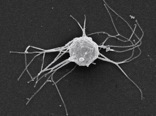
A flagellate is a cell or organism with one or more whip-like appendages called flagella. The word flagellate also describes a particular construction characteristic of many prokaryotes and eukaryotes and their means of motion. The term presently does not imply any specific relationship or classification of the organisms that possess flagella. However, the term "flagellate" is included in other terms which are more formally characterized.

The Percolozoa are a group of colourless, non-photosynthetic Excavata, including many that can transform between amoeboid, flagellate, and cyst stages.

Stephanopogon is a genus of flagellated marine protist that superficially resembles a ciliate.
The microbial food web refers to the combined trophic interactions among microbes in aquatic environments. These microbes include viruses, bacteria, algae, heterotrophic protists. In aquatic ecosystems, microbial food webs are essential because they form the basis for the cycling of nutrients and energy. These webs are vital to the stability and production of ecosystems in a variety of aquatic environments, including lakes, rivers, and oceans. By converting dissolved organic carbon (DOC) and other nutrients into biomass that larger organisms may eat, microbial food webs maintain higher trophic levels. Thus, these webs are crucial for energy flow and nutrient cycling in both freshwater and marine ecosystems.

Telonemia is a phylum of microscopic eukaryotes commonly known as telonemids. They are unicellular free-living flagellates with a unique combination of cell structures, including a highly complex cytoskeleton unseen in other eukaryotes.

David Joseph Patterson is a Northern Irish taxonomist specializing in protozoa and the use of taxonomy in biodiversity informatics.

Ministeria vibrans is a bacterivorous amoeba with filopodia that was originally described to be suspended by a flagellum-like stalk attached to the substrate. Molecular and experimental work later on demonstrated the stalk is indeed a flagellar apparatus.

Malawimonas is genus of unicellular, heterotrophic flagellates with uncertain phylogenetic affinities. They have variably being assigned to Excavata and Loukozoa. Recent studies suggest they may be closely related to the Podiata.

Bigyra is a phylum of microscopic eukaryotes that are found at the base of the Stramenopiles clade. It includes three well-known heterotrophic groups Bicosoecida, Opalinata and Labyrinthulomycetes, as well as several small clades initially discovered through environmental DNA samples: Nanomonadea, Placididea, Opalomonadea and Eogyrea. The classification of Bigyra has changed several times since its origin, and its monophyly remains unresolved.

Holozoa is a clade of organisms that includes animals and their closest single-celled relatives, but excludes fungi and all other organisms. Together they amount to more than 1.5 million species of purely heterotrophic organisms, including around 300 unicellular species. It consists of various subgroups, namely Metazoa and the protists Choanoflagellata, Filasterea, Pluriformea and Ichthyosporea. Along with fungi and some other groups, Holozoa is part of the Opisthokonta, a supergroup of eukaryotes. Choanofila was previously used as the name for a group similar in composition to Holozoa, but its usage is discouraged now because it excludes animals and is therefore paraphyletic.
Katablepharis is a genus of single-celled eukaryotes comprising five to six species. They are heterotrophic and live in both freshwater and seawater. They have two flagella and a feeding apparatus consisting of a mouth and two arrays of microtubules.
The kathablepharids are a group of heterotrophic flagellates (Protists) the first species of which was described by Skuja in 1939 as Kathablepharis phoenikoston,. His spelling was challenged because of non-compliance with botanical nomenclatural conditions, hence the alternative spelling Katablepharis. As the organism was heterotrophic and usually regarded as 'protozoan', and to favour stability, Skuja's original spelling has largely prevailed. With an anterior pocket and ejectisomes, the kathablepharids were thought initially to be cryptomonads. There were a variety of differences with Cryptomonas and other typical cryptomonads = cryptophytes, such as the thickness, length, and beat pattern of the flagella, their phagotrophic habitat, differences in the ejectisomes, and various features of their ultrastructure. The distinctive characteristics of the group were established from electron microscopical studies by Clay and Kugrens and Vørs. More recently they have been tentatively grouped with the chromalveolates, or distantly with the cryptophytes

Picozoa, Picobiliphyta, Picobiliphytes, or Biliphytes are protists of a phylum of marine unicellular heterotrophic eukaryotes with a size of less than about 3 micrometers. They were formerly treated as eukaryotic algae and the smallest member of photosynthetic picoplankton before it was discovered they do not perform photosynthesis. The first species identified therein is Picomonas judraskeda. They probably belong in the Archaeplastida as sister of the Rhodophyta.

Oxyrrhis marina is a species of heterotrophic dinoflagellate with flagella that is widely distributed in the world's oceans.

Kiitoksia is a genus of aquatic protist. The taxonomic position of the genus is still uncertain and it has not found a robust location in any subgroup.

Dinoflagellates are eukaryotic plankton, existing in marine and freshwater environments. Previously, dinoflagellates had been grouped into two categories, phagotrophs and phototrophs. Mixotrophs, however include a combination of phagotrophy and phototrophy. Mixotrophic dinoflagellates are a sub-type of planktonic dinoflagellates and are part of the phylum Dinoflagellata. They are flagellated eukaryotes that combine photoautotrophy when light is available, and heterotrophy via phagocytosis. Dinoflagellates are one of the most diverse and numerous species of phytoplankton, second to diatoms.

Neobodo are diverse protists belonging to the eukaryotic supergroup Excavata. They are Kinetoplastids in the subclass Bodonidae. They are small, free-living, heterotrophic flagellates with two flagella of unequal length used to create a propulsive current for feeding. As members of Kinetoplastids, they have an evident kinetoplast There was much confusion and debate within the class Kinetoplastid and subclass Bodonidae regarding the classification of the organism, but finally the new genera Neobodo was proposed by Keith Vickerman. Although they are one of the most common flagellates found in freshwater, they are also able to tolerate saltwater Their ability to alternate between both marine and freshwater environments in many parts of the world give them a “cosmopolitan” character. Due to their relatively microscopic size ranging between 4–12 microns, they are further distinguished as heterotrophic nanoflagellates. This small size ratio limits them as bacterivores that swim around feeding on bacteria attached to surfaces or in aggregates.
Minorisa is a monotypic genus of marine heterotrophic flagellates that is heavily featured in the eukaryotic picoplankton of coastal ecosystems. It is part of the supergroup Rhizaria, at the base of the class Chlorarachniophyceae.

Urceolus is a genus of heterotrophic flagellates belonging to the Euglenozoa, a phylum of single-celled eukaryotes or protists. Described by Russian biologist Konstantin Mereschkowsky in 1877, its type species is Urceolus alenizini. Species of this genus are characterized by deformable flask-shaped cells that exhibit at least one flagellum that is active at the tip, arising from a neck-like structure that also hosts the feeding apparatus. They are found in a variety of water body sediments across the globe. According to evolutionary studies, Urceolus belongs to a group of Euglenozoa known as peranemids, closely related to the euglenophyte algae.
Urceolus cornutus is a species of heterotrophic flagellates present in marine environments. Described in 1990 by Jacob Larsen and David Patterson from sediment samples off the coast of Fiji, it is distinguished from other species by very fine and compact pellicle stripes that follow an S-helix shape, and a collar with a regular or symmetrical outline.















